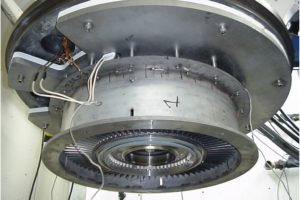Advancing Aerodynamic Pulse Generation
June 1, 2014

The APG test method utilizes special hardware in a partial atmosphere test chamber to excite the rotating blades. Both methods are used to excite blades at different conditions, evaluating their resonance response in a rotational frame. One unique benefit of APG is that it can be performed in high temperature environments. Since high temperature testing is one of Test Devices’ core technical competencies, advancing a High Temperature HCF method was a natural direction.
The APG method was developed over 20 years ago, and although this effective method had been employed successfully over that period, the parameters that contributed to the success were not well understood. Through analysis and additional experimentation, the company’s engineers have gained a more thorough understanding of the mechanics of Dynamic Spin Testing with APG excitation. The first step to improving this method was to upgrade the test facility to provide a higher powered drive system that can run APG test rigs at higher atmospheric levels, which can create a stronger blade response.
The next step was to undertake the difficult task of trying to assess the exact nature of what was contributing to the well validated response within the Dynamic Spin Rig®. A CFD analysis of the complex conditions within the Dynamic Spin Rig provided insight into the parameters that create the pulse response. Based on this information, new hardware was developed that optimized the pulse generation. The enhanced hardware was validated in early 2014, showing significantly increased blade response and confirming the underlying principles of the APG excitation method. “Based on test results, we gained more confidence in achieving blade excitation levels up to six times higher than before,” Chief Technology Officer Hiro Endo said. “We validated many of our hypotheses, which gave us a firm direction to take as we worked to optimize HCF excitation.”
Two decades ago, Test Devices first validated its original APG methods. Material advances, including the industry move from metal to non-metal blades, initiated the company’s redevelopment. While shaker tables provide fundamental information about blade response, there is a need for component test data in a realistic, rotating environment more economic than full engine testing. Conducting HCF testing with a Dynamic Spin Rig allows a more focused evaluation of the blade response than is possible in an engine test, as well as the ability to hold resonance conditions for millions of cycles.
Thanks to this latest advancement, Test Devices will increase the response amplitude and provide more comprehensive data to customers. “Our intention is to see if customers’ materials are robust enough to withstand HCF forces as well as to capture the force and conditions that allow us to identify at what precise point the part will fail,” Endo added. “HCF is a complex phenomenon and one that provides great insight for customers to use in their designs.”

